#Arupadai Veedu
Explore tagged Tumblr posts
Text
Arupadai Veedu Temple Tour - The Holiday Destination

The Holiday Destination: Your Gateway to the Arupadai Veedu Temple Tour
The Holiday Destination, located in Madurai, offers a unique travel experience for travelers and devotees. They offer the Arupadai Veedu Temple Tour, a sacred pilgrimage to Lord Murugan, through six revered abodes. The company provides personalized services and seamless arrangements for an exceptional experience.

What is the Arupadai Veedu Temple Tour?
The Arupadai Veedu Temple Tour is a spiritually enriching journey that covers six holy shrines of Lord Murugan in Tamil Nadu.
Temples of Lord Murugan • Thiruparankundram: Cave temple where Lord Murugan married Deivanai. • Thiruchendur: Coastal temple commemorating Murugan's victory over Surapadman. • Palani: Hill temple known for Dhandayuthapani Swamy and Kavadi practice. • Swamimalai: Temple where Murugan imparted sacred "Om" to Shiva. • Thiruthani: Serene hill temple where Murugan attained divine status. • Pazhamudircholai: Verdant temple symbolizing Murugan's wisdom and benevolence.
The Arupadai Veedu Temple Tour is a cherished pilgrimage for devotees due to its unique significance and spiritual experience at each temple.

Why Choose The Holiday Destination for Your Arupadai Veedu Temple Tour?
The Holiday Destination offers a personalized pilgrimage experience by curating customized itineraries covering all six temples in a seamless sequence. They provide end-to-end travel arrangements, including comfortable transportation, accommodation options, and guided tours at each temple.
Experienced guides provide valuable insights into the history, legends, and significance of each temple, ensuring a deeper understanding and connection with the sacred sites. They also assist with practical aspects like navigating temple queues and understanding local etiquette.
The Holiday Destination offers flexible packages tailored to different preferences and budgets, with transparent pricing to ensure the best value for money. They also provide comprehensive support throughout the journey, including 24/7 customer assistance for queries or emergencies, ensuring your comfort and satisfaction.

Highlights of the Arupadai Veedu Temple Tour
Temple Tour in Tamil Nadu: • Scenic Routes: Enjoy picturesque landscapes and serene surroundings. • Cultural Experiences: Engage in local festivals, rituals, and traditions. • Spiritual Fulfillment: Participate in poojas, abhishekams, and rituals at each temple. • Local Cuisine: Enjoy authentic South Indian cuisine. • Historical Insights: Learn about architectural marvels and historical significance of each temple.
Book Your Arupadai Veedu Temple Tour with The Holiday Destination
The Holiday Destination offers a spiritually rewarding and culturally enriching Arupadai Veedu Temple Tour, renowned for its personalized services, expert guidance, and seamless travel arrangements. Join us for a journey through Lord Murugan's divine abodes and create lasting spiritual memories.
#travel and tours#the holiday destination#Arupadai Veedu Temple Tour packages#temple tour Packages#madurai tour and travels#cab service#travels#taxi service#kerala tour packages#kochi tour packages
2 notes
·
View notes
Text
Thaipusam 2025: Significance, Rituals & Best Murugan Temples to Visit
Introduction:
The Thaipusam Festival 2025 falls on February 11, 2025. This auspicious Hindu festival is observed on the full moon day in the Tamil month of Thai (January–February), when the Poosam Nakshatra aligns with the moon. Thaipusam 2025 Date marks a powerful time for spiritual growth, penance, and devotion to Lord Murugan, the deity of valor and wisdom.
Significance of Thaipusam Festival
The History of Thaipusam and Lord Murugan is deeply rooted in Hindu mythology. It commemorates the moment when Goddess Parvati gifted the Vel (divine spear) to Lord Murugan to defeat the demon Soorapadman, symbolizing the victory of good over evil.
This festival is widely celebrated in Tamil Nadu, Sri Lanka, Malaysia, and Singapore, where devotees express their gratitude through intense penance, carrying Kavadi Attam, and participating in special poojas at Murugan temples.
Thaipusam Rituals and Traditions
Devotees prepare for Thaipusam 2025 through:
✅ Fasting Rules for Thaipusam – Many observe strict vegetarian diets for 48 days before the festival. ✅ Carrying Kavadi Attam – Devotees carry beautifully decorated Kavadi as an act of devotion. ✅ Piercing Rituals – Some pierce their cheeks, tongue, or body to show unwavering faith. ✅ Milk Pot Offerings (Paal Kudam) – Devotees carry milk pots to Murugan temples for Thaipusam temple darshan booking 2025. ✅ Chanting and Processions – Devotees sing bhajans and walk barefoot to temples.
Best Places to Celebrate Thaipusam in Tamil Nadu
1️) Palani Murugan Temple – The most famous Thaipusam celebration\ in Tamil Nadu. 2️) Tiruttani Murugan Temple – A sacred site on the Chennai to Tiruttani Murugan Temple tour package. 3️) Swamimalai Murugan Temple – One of the 6 Homes of Lord Murugan. 4️) Thiruchendur Murugan Temple – A must-visit for a special Murugan temple darshan for Thaipusam. 5️) Madurai Tiruparankundram – One of the Arupadai Veedu temples where Lord Murugan married Deivanai.
Chennai to Arupadai Veedu Tour Package for Thaipusam 2025
For devotees planning a pilgrimage, the Chennai to Arupadai Veedu Tour Package is the perfect spiritual journey covering all 6 Abodes of Lord Murugan:
Day 1 – Chennai to Tiruttani Murugan Temple for Thaipusam Pooja Timings 2025. Day 2 – Visit Swamimalai Murugan Temple & Pazhamudircholai Murugan Temple. Day 3 – End the pilgrimage with Thiruchendur Murugan Temple visit.
Day 4 – Pazhamudircholai is a sacred hill temple near Madurai in Tamil Nadu, dedicated to Lord Murugan.
Days 5 – Thiruparankundram is a historic temple town located near Madurai in Tamil Nadu, known for the Thiruparankundram Murugan Temple.
Day 6 – Experience the Thaipusam Festival in Tamil Nadu at Palani Murugan Temple.
Why Visit Murugan Temples on Thaipusam 2025?
Spiritual Transformation – Thaipusam celebrations in Tamil Nadu are a path to self-purification.
Blessings of Lord Murugan – Experience divine grace at the best Murugan temples to visit during Thaipusam.
Once-in-a-Lifetime Experience – Witness devotees carrying Kavadi Attam in a mesmerizing procession.
Why Choose Us?
Comfortable Transport: Air-conditioned buses and cars with spacious seating for a relaxing journey.
Experienced Drivers: Skilled drivers familiar with temple routes for a safe, hassle-free trip.
Customizable Itinerary: Flexible schedules and a well-planned visit to all six Arupadai Veedu temples.
Value-Added Services: Help with accommodation, expert guidance on temples, rituals, and nearby attractions.
Affordable Pricing: Transparent pricing with no hidden charges, special packages for groups and families.
Trusted Reputation: Known for exceptional service and customer satisfaction.
Conclusion:
Thaipusam Festival 2025 is not just a religious event but a celebration of devotion, faith, and inner strength. Whether you’re planning a Chennai to Arupadai Veedu tour package or seeking special Thaipusam temple darshan booking 2025, this is the best time to embark on a Sacred journey to Lord Murugan’s temples.
For bookings and inquiries, contact us at:
Phone: +91-9962717100 Email: [email protected] Website: www.balajidarshanbooking.com Address: 18, 3rd Avenue, New Colony, Arumbakkam, Chennai, Tamil Nadu 600106
0 notes
Text

Explore our exquisite collection of Murugan idols, crafted with precision in brass, bronze, and Panchaloha. Each idol symbolizes wisdom, courage, and divine grace, making it perfect for home altars, temples, or gifting. From Murugan with Vel (Spear) to Arupadai Veedu idols, our designs capture the essence of spiritual and cultural heritage. Meticulously crafted by skilled artisans, these idols radiate divine energy and elevate your sacred spaces.
Discover the perfect idol to bring protection, success, and positivity into your life.
Website: Idol Bronze Business Enquiry: 6383910192
0 notes
Text
3 Nights 4 Days Arupadai Veedu Tour Packages
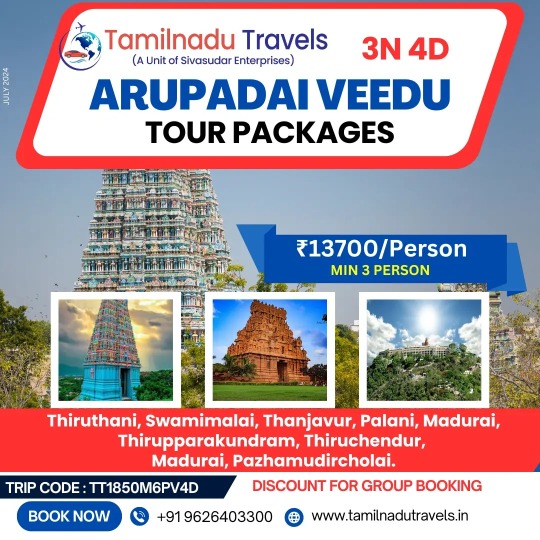
Join us on an enriching 3 Nights 4 Days #arupadaiveedu Tour Package, visiting the most revered Murugan temples across Tamil Nadu. Experience the divine and explore the beauty of these sacred sites with our expertly planned itinerary.
Day 1: #chennai – #thiruthani – #kumbakonam
Visit the Thiruthani Murugan Temple and seek blessings for a prosperous journey.
Day 2: #kumbakonam – #swamimalai– #thanjavur – #palani – #madurai
#swamimalaimurugantemple: Begin your day with divine blessings.
Explore the historic city of #thanjavur
Pay your respects at the #palanimurugantempleTemple
End your day with a visit to the majestic #maduraimeenakshiammantemple
Day 3: Madurai – #thiruchendur – Madurai
Visit the serene #thiruchendurmurugantemple
Return to Madurai Meenakshi Temple for an evening of devotion.
Day 4: Madurai – #pazhamudircholai – #Tiruparankundram– Madurai
Start your day at the #thiruparankundrammurugan
Complete your spiritual journey with a visit to Pazhamudircholai Murugan Temple.

Visit Us - https://www.tamilnadutravels.in/3-nights-4-days-arupadai...
For more details and to reserve your spot, visit our website: 3 Nights 4 Days Arupadai Veedu Tour Packages
0 notes
Text
15 Days Tamilnadu Tour Package Trichy To Trichy
+91-74181-33135 / [email protected]
15 Days Tamilnadu Tour Package Trichy To Trichy
DAY 1 : Arrival in Trichy - Beginning the Tamil Nadu Adventure
Upon arrival at Trichy International Airport, your Tamil Nadu journey commences with a visit to the renowned Sri Ranganathaswamy Temple in Srirangam, followed by the Rockfort Ucchi Pillayar Temple. Subsequently, continue your drive to Tiruvannamalai, where you can enjoy a well-deserved rest at the hotel. Overnight accommodation will be provided in Tiruvannamalai.
DAY 2 : Tiruvannamalai to Tirupati - A Spiritual Journey
Begin your day with a visit to the Sri Arunachaleshwara Temple in Tiruvannamalai, where Lord Shiva represents the element of "Fire." Afterward, continue your journey to Tirupati. Along the way, make a stop to explore the stunning Golden Temple in Vellore, dedicated to Goddess Lakshmi. Arrive in Tirupati, check in at the hotel, and enjoy a comfortable overnight stay.
DAY 3 : Tirupati Pilgrimage - Seek Divine Blessings
Embark on a spiritual journey in Tirupati by first seeking the blessings of Lord Venkateswara at Tirupati Balaji Temple. Afterward, drive to Srikalahasti, where you'll visit the Shiva Temple, representing one of the five elements of Nature, "Air." Conclude your day with a visit to Alamelumangapuram Perumal Temple. Return to your hotel in Tirupati for a well-deserved rest, and enjoy one more night in this sacred city.
DAY 4 : Spiritual Sojourn from Tirupati to Chennai
Set out on a spiritual journey from Tirupati to Chennai. Along the way, embark on an Arupadai Veedu Tour with a visit to Thiruthani Murugan Temple, one of the Arupadaiveedu temples. Continue your drive to Kanchipuram, renowned for its temples. Explore the Ekambareswarar Temple, where Lord Shiva symbolizes one of the five elements of nature, "Earth," and visit the Kamakshi Amman Temple. Finally, arrive in Chennai, where you can unwind and spend the night at your hotel.
DAY 5 : Chennai Delight - Explore the Capital City
Enjoy a full day exploring the vibrant city of Chennai. Visit renowned attractions like the picturesque Marina Beach, the historic St. Thomas Church, and the culturally rich Kapaleeswarar Temple. Afterward, immerse yourself in some leisurely shopping. Return to your hotel for a well-deserved rest, with one more night to relish the charms of Chennai.
DAY 6 : Mahabalipuram and Tranquil Pondicherry - A UNESCO Journey
Today presents an opportunity for you to partake in a journey to the UNESCO World Heritage Monument sites. Commencing in the morning, we will embark on a drive to the historical city of Mahabalipuram. Here, we will visit the renowned World Heritage UNESCO Monuments, including Arjuna's Penance, Sea Shore Temple, and Five Rathas ("Five Chariots"). Following this, we will proceed to Pondicherry, the French Union Territory, where we will indulge in the Pondicherry City Trip. This will entail visits to the esteemed Sri Aurobindo Ashram, Manakula Vinayagar Temple, Beach Side, French Quarters, and more. After a day of exploration, we will retire to our hotel for a well-deserved rest. Our stay in Puducherry will be overnight.
DAY 7 : Temples and Tranquility - Karaikal Bound
Following breakfast, proceed to Karaikal via a spiritual journey to the renowned Nataraja Temple in Chidambaram. Here, Lord Shiva represents the element of "Sky" in nature. Continue your journey with a Navagraha Trip, visiting temples such as the "Sevvai" Temple in Vaitheeswaran Kovil, the "Budhan" Temple in Thiruvenkadu, the "Kethu" Temple in Keezhaperumpallam, the Abirami Temple in Thirukadaiyur, and the "Sani" Temple in Thirunallaru. Upon arrival in Velankanni, take a break and relax in your hotel. Overnight stay in Karaikal.
DAY 8 : Pilgrimage and Tranquil Temples
Begin your journey to Velankanni Trip in the morning. Pay a visit to the renowned Catholic Church of Tamil Nadu, "Our Lady of Good Health," located in Velankanni. Following that, proceed with your journey to reach Kumbakonam. Set out on a journey to discover the Navagraha Temples Tour, ensuring a visit to temples like Alangudi "Guru" Temple, Thirunageswaram "Rahu" Temple, Suriyanar Kovil "Sun" Temple, Kanjanoor "Sukran" Temple, and Kumbakonam Sarangapani Temple along your route. Take a well-deserved rest at the hotel and enjoy an overnight stay in Kumbakonam.
DAY 9 : Divine Journey through Heritage and Temples
In the morning, embark on a journey to Rameshwaram. Along the way, make a stop at the Swamimalai Murugan Temple, one of the Arupadaiveedu, and the Thingalur "Chandran" Temple for the Arupadai Veedu Trip. Afterward, continue your drive to indulge in the Tanjore City Trip. During this journey, take the opportunity to visit the renowned Thanjavur Brihadeeswara Temple, also known as the Big Temple, which was constructed in the 10th century by the Chola dynasty and is recognized as a distinguished World Heritage Site. Proceed towards Rameshwaram, making a detour to the famous Karpaga Vinayaga Temple at Pillayarpatti. Finally, arrive in Rameshwaram and find respite in the comfort of your hotel. Enjoy an overnight stay in Rameswaram.
DAY 10 : Spiritual Odyssey to Southern Land's End
Begin your holy trip to Rameshwaram in the morning. Pay a visit to the renowned Rameshwaram Ramanathaswamy Temple and partake in a sacred dip in the 22 water tanks located within the temple premises as a means of purification. Afterward, set off on a trip to Kanyakumari, the point where the Bay of Bengal, the Arabian Sea, and the Indian Ocean meet, marking the southernmost tip of the Indian Peninsula. Along the way, make a stop for the Arupadai Veedu Trip, allowing you to visit one of the esteemed Arupadaiveedu dedicated to Lord Muruga in Tiruchendur, situated near the seashore. As the evening approaches, commence your Kanyakumari City Trip, exploring significant landmarks such as Vivekananda Rock, Kumari Amman Temple, Mahatma Gandhi Memorial, Thiruvalluvar Statue, and witnessing the mesmerizing sunset. Enjoy an overnight stay in Kanyakumari.
DAY 11 : Journey from Kanyakumari to Madurai's Majesty
Commence your day by embarking on a journey to Madurai in the morning. While en route, make a halt for the Arupadai Veedu Trip, where you can pay a visit to the Tiruparankundrum Murugan Temple and Pazhamudhircholai Murugan Temple, which are considered to be the two most significant Arupadaiveedu. In the evening, indulge in the Madurai Heritage Trip and explore the renowned landmarks such as the Meenakshi Amman Temple and Thirumalai Nayaka Palace. Spend the night in Madurai.
DAY 12 : Ascend to Kodaikanal's Serene Heights
Commence your journey to Kodaikanal, the hill station, in the morning. Take a break in the refreshing hill climate and spend the night in Kodaikanal.
DAY 13 : Embrace Kodaikanal's Natural Beauty
Today is the opportune moment to embark on a Kodaikanal City Trip. Following breakfast, a comprehensive day of sightseeing in Kodaikanal awaits. It is recommended to visit significant tourist attractions such as Lake View, Boat Ride, Bryant's Park, Coaker's Walk, Silver Falls, View Point, and Pillar Rock, among others. Another night's accommodation in Kodaikanal is suggested.
DAY 14 : Journey from Kodaikanal to Trichy via Palani
In the morning, embark on a journey to Trichy. Along the way, make a stop at the renowned Palani Murugan Temple, one of the Arupadaiveedu, for an Arupadai Veedu Trip. Afterwards, resume your drive towards Trichy. The remaining time will be at your leisure for shopping. Upon arrival, take some time to relax at the hotel. Enjoy an overnight stay in Trichy.
DAY 15 : Farewell from Trichy
On this day, your Tamil Nadu Trip will conclude, leaving you with cherished memories. You will be transported to Trichy International Airport, Trichy, in accordance with your flight schedule for your journey back home.
#southindiatourpackageswithitineary#templetour#tour package#travel agency#southindiatourstravelsmadurai#15daystamilnadutourpackage
0 notes
Text

Chennai to Sholingur Car, Tempo Traveller rentals. For Booking Chennai to Sholingur Day trip Pl Call Us +91 9841862359 or Whatsapp at +91 9176070718
More Details Visit at
Tamilnadu Temple Tour Packages
Arupadai Veedu Tour Packages
0 notes
Photo

Murugan is known by numerous names in ancient and medieval texts of the Indian culture. Most common among these are Mahasena, Kartikeya, Kumara, Shanmukha, Skanda, and Subrahmanya . He is the Hindu god of war. He is a son of Parvati and Shiva, brother of Ganesha, and a god whose life story has many versions in Hinduism
✨
Murugan – the Hindu God of Tamils
Murugan is hailed as ‘Thamizh kadavul’ — the Lord of Tamils by poets and Tamil cultural exponents who take pride in the uniqueness of Tamil culture. Murugan is a popular deity widely worshiped in Tamil Nadu and also in Kerala, Karnataka and Srilanka. Worship of Muruga is rather sporadic in other parts and linguistic segments of India.
The myriod Tamil names of Murugan
The word Murugan means one who is handsome. In India, naming children with popular names of God is very widely practiced. The name Murugan and his numerous other names like Murugaiyan, Sivamurugan, Velmurugan, Saravanan, Karthigeyan, Senthil, Arumugam, Subramaniyan, Subbaiah, Subbarayan, Swaminathan, Velan, Kadirvel, Shaktivel, Kandan (Skandan), Kandaswamy, Kadamban, Kumar, Kumaraswamy, Shivakumar, Shanmukham, Palani (it is actually the name of one of his abodes), Palaniswamy, Muthu Kumaran, Sakthi Kumar, Muthukumaraswamy, Dandapani, Dandayutapani, etc. are widely used in naming children; a vast majority in the above names are quite typical to Tamils.

The birth of Murugan
Murugan is Subramanya, the son of lord Shiva. According to mythology, Murugan was born out of the fire that emanated from Lord Shiva’s third eye — his eye at the middle of his forehead, when he opened it to burn Kamadeva, or Manmatha, the god of love and passion, who tried to disturb Shiva’s meditation and turn his mind towards romance. The very purpose of birth of Muruga was to annihilate the two demons Tarakasura and Surapadma. Elaborate details of this mythology can be obtained from “Skanda Puranam”. The tamil poetic version of this mythology is also available, known as “Kanda Puranam” written by the poet Kacchiappa Sivachariyar (1350-1420).
Puranas
The Skanda Purana narrates that Shiva first wed Dakshayani (also named Sati), the granddaughter of Brahma, and the daughter of Daksha. Daksha never liked Shiva, who, symbolizing destruction and detachment, begs for food, dances in a graveyard smeared with ashes, and has no possessions, not even good clothes for himself. Daksha publicly insulted Shiva in a Yagna ceremony, and Sati immolated Herself in anger over this treatment of Her husband. The Yagna was destroyed by the ganas of Shiva led by Virabhadra. Shiva withdrew himself from the universe and engaged himself in yogic meditation in the Himalayas.
In the meanwhile, Surapadman (an asura) ravaged the earth and tormented its beings. Tarakasuran believed that, because Shiva is an ascetic and his earlier marriage was conducted with great difficulty, his remarriage was out of the question, hence his boon of being killed by Shiva's son alone would give him invincibility.
It was realized by the gods that only the son born of Shiva could lead the gods to victory over Tarakasuran, Surapadman and their companions. They plotted with Manmatha, also known as Kamadeva, the God of love, to shoot a flower arrow from his bow at Shiva, as he sat in meditation, so as to make him fall in love with Parvati (who was Dakshayani, reborn). When Kamadeva aimed his arrow, Shiva opened his third eye and incinerated him to ashes instantly.

Shiva handed over his effulgence of the third eye, used to destroy Manmatha, to Agni, as he alone was capable of handling it until it becomes the desired offspring. Even Agni, tortured by its heat, handed it over to Ganga, who in turn transported it into the Saravana Forest and deposited it in a pond of reeds called the Saravana Poigai (located at mouths of river Ganga) , where the sparks became six children. They were raised by the six Krittika or Kartika - the stars that make up the Pleiades, earning the name Karthikeya. Parvati combined these six babies into one with six faces, i.e. Shanmukha or Arumugan. Since he was born in the Saravana he was also called 'Saravanabhava'.

Murugan became the supreme general of the demi-gods then escorted the devas and led the army of the devas to victory against the asuras.
Murugan’s vehicle is peacock and his main weapon to destroy his enemies is “Vel” (lance). His army flag (“kodi“) carries the symbol of rooster (“seval“) and on account of it, he is also known as “Seval Kodiyon“.
According to mythology, Lord Murugan is married to two wives, Devayani (daughter of Indra, the king of Devas) and Valli. Valli reportedly belongs to a Tamil tribal community.

Murugan and Gyana (Supreme Knowledge)
Mahavakyam - "The Great Sayings" of the Upanishads:
प्रज्ञानम् ब्रह्म, Prajñānam Brahm, Consciousness is God. ~ Aitareya Upanishad (Chapter 3, verse 3)
अहं ब्रह्मास्मि, Ahaṁ Brahmāsmi ~ Brihadaranyaka Upanishad 1.4.10 of the Shukla Yajur Veda
Aham (अहं) means “I”, Brahm (ब्रह्म) means all possibilities and Asmi (अस्मि) means “am”.
तत्त्वमसि, Tát Túvam Asi ~ Chandogya Upanishad 6.8.7 of the Sama Veda
tát (तत्) means “That”, túvam means “You”, Asi “are”. Simply put, Thou art that.
🌺 ॐ 🌺
Realizing the highest truth of the Atman, and its oneness with the Brahman, is called gyana (true knowledge) in Hinduism. Attaining this knowledge is also known as the opening of the “third eye” in a person. Lord Murugan, who was born on account of the opening of the third eye of Lord Shiva is a knower of the supreme truth and is therefore referred to as “Gyana Panditan” (An exponent of Supreme knowledge).
The holy Hindu syllable “Om” is said to encapsulate the Supreme knowledge; one who knows the profoundest meaning of Om is indeed a Gyani who knows the Supreme Truth. According to mythology, Murugan, even as a little boy was aware of the meaning of Om.
On one occasion Murugan imparted a secret upadesa on pranava, the sound of Om, to Shiva and thus earned the title ‘Guru of Shiva’.

Since Murugan thus became a Guru (Swami) who taught to the very Lord (Natha) of the universe, he was called Swaminathan. In Tamil, he is hailed as “Thagappan Sami” – one who became a Guru to his own father.
✨
Ramana Maharshi as Skanda son of Shiva
Bhagavan Sri Ramana Maharshi, the very embodiment of the beginningless infinite supreme Brahman, the Satchitananda (existence, consciousness, bliss), is considered by his ardent devotees to be an incarnation of Lord Muruga. Though he has not written any hymns about Muruga, his cryptic poems are a source of treasure which contains the essence of his philosophical teachings.
Maharshi Ramana has taught two principal paths as the main spiritual practices [sadhanas] for the attainment of Self-Knowledge, which is the state of eternal, perfect and unalloyed happiness. The first path He taught is the path of Self-Enquiry, that is, knowing oneself (one’s real nature) by enquiring ‘Who Am I?’, while the second path is the path of self-surrender, that is, surrendering oneself (the ego) completely to God. The former is the path of knowledge or gyana (jnana marga), and the latter is the path of devotion (bhakti marga).
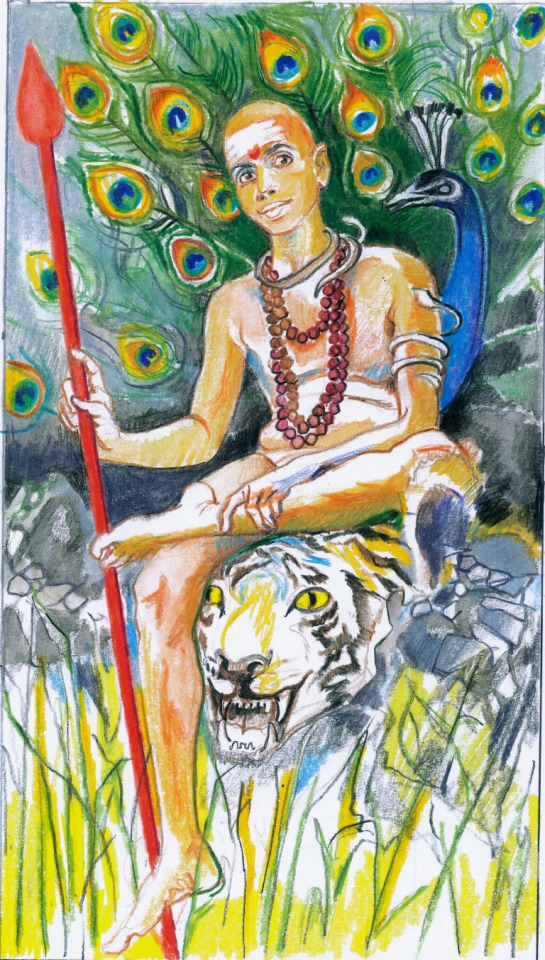
Jane Adams Art - SACRED INDIA TAROT – RAMANA AS SKANDA SON OF SIVA
✨
The 6 great abodes of Murugan in Tamil Nadu
The six sites at which Karthikeya sojourned while leading his armies against Surapadman:
Swamimalai - Arulmigu Swaminatha Swamy Temple - A very famous temple of Swaminathan (i.e. Murugan), situated at Swamimalai (near Kumbakonam at Tamil Nadu, India), is treated as the most sacred place as where Lord Murugan preached the Pranav Mantra “OM” to His father Lord Shiva when He was a child.
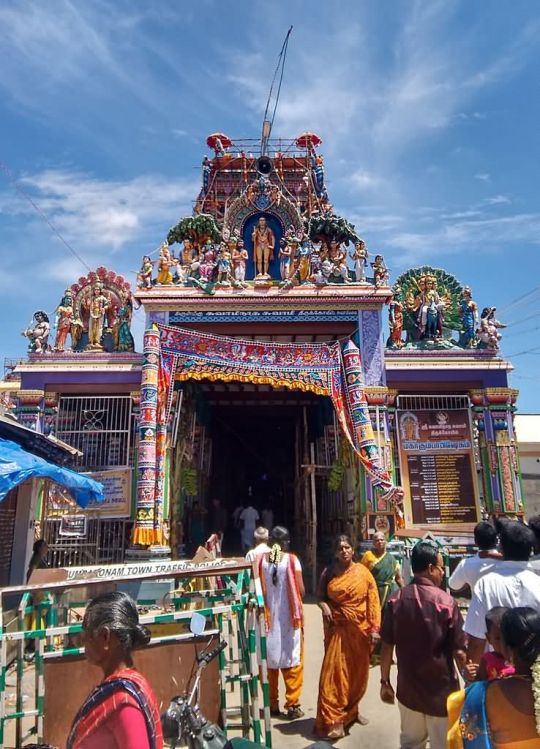
The other 5 abodes are : Tiruttanikai, Tiruvavinankudi (Palani), PazhamudirSolai, Tirupparamkunram and Tiruchendur.
“Thirumurugatruppadai” is a famous and ancient Tamil literature written by poet Nakkirar of the Sangam period (circa the 3rd century AD), which contains the stories of the wondrous divine play of Lord Murugan in all these 6 main abodes.
These six sites collectively came to be known as "Arupadai Veedu" (Lang:Tamil), it means the six battle camps of the Lord.
Worship in Tamil Nadu
Thai Poosam during January-February month is celebrated as a 6-day festival. On Thai Poosam day, Kavadis and Palkudams are taken by devotees in procession around Chhedanagar. Special Abhishekams are performed to the Moolavar and Utsavar (festival deity's moorthi usually taken during temple festival processions; utsavar moorthi is generally made of metal, and Moolavar murthi is usually made of stone). Annadhanam (The Sacred Offering of Food) is provided to all devotees participating in the functions. In the night, Lord Muruga is taken in procession accompanied by Nadaswaram, Veda Parayanam around Chhedanagar.
Vaikasi Visakam day, during May-June month, Kavadis (a 'physical burden' made out of elaborate and decorated framework, lifted onto a person’s shoulders) and Palkudams (milk pots) are taken by devotees in procession around Chhedanagar.
Skanda Sashti during October-November month is celebrated as a 6-day festival. Spiritual discourses by learned scholars and/or music concerts by popular artists from South or from Mumbai are organized.
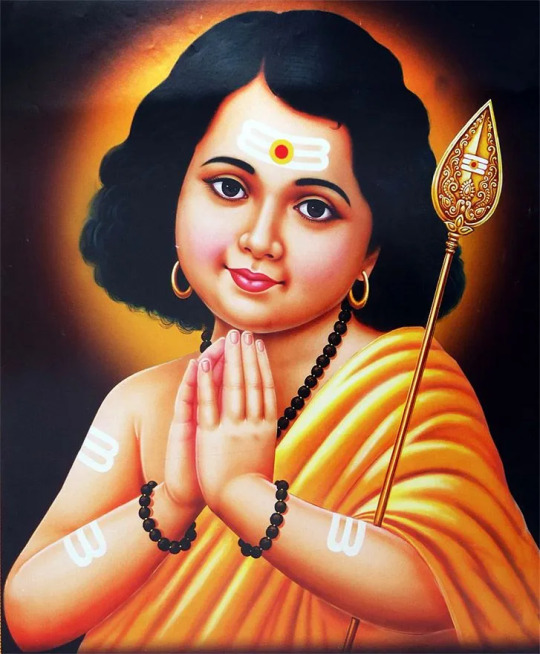
#Bhagavan Sri Ramana Maharshi#Kartikeya#Karttikeya Skanda Kumara Murugan Mahasena Shanmukha Subrahmanya#Pranava OM#Arupadai Veedu#mahavakya#That Thou Art
44 notes
·
View notes
Text
Sudoku Concept With Sadakshara Six In Palani Temple Inscription
When one researches Indian history through Indian sources like ancient Sanskrit and regional languages texts like Tamil and Temole architecture,which is a source of rich historical information,one is amazed.
I had written extensively on these findings.
On Palani Dhandayuthpani temple, I have written how a committee constituted by The Government of Tamil Nadu,which had scientists in the panel,…
View On WordPress
#Arupadai Veedu#Dhandauthapani#Palani inscription#Palani temple#Sudoku#Tamil Inscriptions#Tamil Sudoku#Temples of Tamil Nadu Temples of India
2 notes
·
View notes
Text
Lord Murugan's Temple at Tiruchendur
Lord Murugan’s Temple at Tiruchendur
Tiruchendur-Arupadai Veedu The Tiruchendur Kovil (Temple) represents the 2nd House of residence among the 6 important residences of Lord Murugan. It thus represents the 2nd Arupadai Veedu. Many believe the Tiruchendur Kovil to be 3000 years old. Many mysteries surround this great temple of Lord Murugan in the South of India. Appearance of Lord Murugan Lord Shiva did not bear any children…

View On WordPress
#Appearance of Lord Murugan#Brihaspati undertakes Penance#Deity worship at Tiruchendur#Devi gives Shakti Vel to Murugan#No Mango trees near the Tiruchendur temple#Sooran Padma Vadham#Sweating Deity at Chikkal#The “Nazhikenur” well at Tiruchendur#The Dutch try to steal the Subrahmanya deity#Tiruchendur becomes the battle place#Tiruchendur temple protects against Tsunami#Tiruchendur-Arupadai Veedu#Vada Malai Appar retrieves Subrahmanya#Waters at Tiruchendur like Ganga Water
0 notes
Text

Temple Tour Packages in Madurai - The Holiday Destination
#tours and travels#The Holiday Destination#kerala Tour Packages#Arupadai Veedu Temple Tour#Temple Tour Packages in Madurai#Cab Rental in Madurai
3 notes
·
View notes
Text
Plan Your Arupadai Veedu Tour from Chennai for Thaipusam

Introduction:
During the 2025 Thaipusam festival, do you intend to visit the Arupadai Veedu temples? You’ve come to the correct site if you’ve been wondering about the significance and customs of the event or if you can reserve the Chennai to Arupadai Veedu Tour Package for Thaipusam.
We’ll address all of your immediate questions in this article, such as the dates of Thaipusam 2025 celebrations, the customs involved, and the specifics of Padmavathi Travels Chennai to Arupadai Veedu Tour Package.
Thaipusam: A Time of Devotion
An opportune time to undertake this pilgrimage is during Thaipusam, a significant festival dedicated to Lord Murugan. In 2025, Thaipusam falls on February 11th. The Poosam Nakshatra (star) begins on February 10th at 6:01 PM and ends on February 11th at 6:34 PM.
Celebrated with fervor, Thaipusam marks the occasion when Goddess Parvati bestowed the “Vel” (spear) upon Lord Murugan to vanquish the demon Soorapadman. Devotees often undertake rigorous vows, carry “kavadi” (burdens), and participate in elaborate processions to express their devotion.
Tour Package Overview
Our Chennai to Arupadai Veedu Tour Package starts from Chennai and covers all six temples dedicated to Lord Murugan. You will visit each temple, spend time praying, and enjoy the peaceful surroundings. We provide air-conditioned transport, such as AC Sedans, SUVs, or Tempo Travellers, so you travel comfortably throughout the trip.
Chennai to Arupadai Veedu Tour Package Price Details:
ETIOS/SWIFT DESIRE AC (4+1 seater): ₹36,000
INNOVA/ERTIGA AC (6+1 & 7+1 seater): ₹46,000
INNOVA CRYSTA AC (6+1 & 7+1 seater): ₹52,000
TEMPO TRAVELLER AC (12+1 seater): ₹56,000
0 notes
Text

The Pazhamudircholai Murugan idol represents Lord Murugan, enshrined at the sacred Pazhamudircholai temple, one of his six abodes (Arupadai Veedu). Depicted with divine grace, he symbolizes wisdom, valor, and compassion. Worshipping this idol is believed to bring knowledge, success, and protection to devotees.
For high-quality replacements, you might consider exploring the collection at Idol Bronze, which offers a variety of meticulously crafted brass and bronze idols.
For Business Enquiry - 6383910192
0 notes
Photo
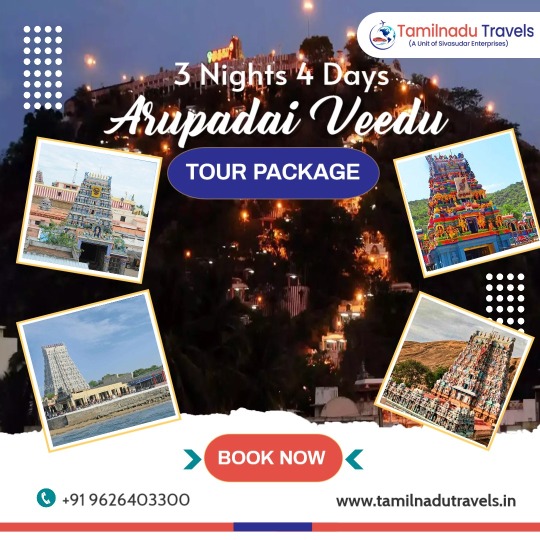
3 Nights 4 Days
Arupadai Veedu Tour Package
Contact - +91 9626403300 / 7449109109
https://tamilnadutravels.in/arupadai-veedu-tour-package.html
During your Arupadai Veedu Tour Package, you may be worried about finding the right hotel for you that too in a budget. While you search over the internet for the best option, we have already shortlisted the best available hotels as per star ratings. Our Arupadai Veedu Tour Package are not only customizable but also affordable. You do not have to spend a fortune when you book with us.
To ensure that your entire tour remains hassle-free, we have also included sightseeing and transfers along with a guide. You will also be picked up by our agent’s representative on your arrival at the airport/station. From your pick up till drop, everything will be taken care of. Enjoy the serene landscape and fabulous attractions while we take care of all your travel worries.
#tour#tourist#tours#tour and travel#tour packages#travel#travels#Tours and Travels#cab#car rental#car hire#call taxi#carrental#kumbakonam#palani#madurai#tiruchendur#Chennai
1 note
·
View note
Text
15 Days Tamilnadu Tour Chennai To Chennai
+91-74181-33135 / [email protected]
15 Days Tamilnadu Tour Chennai To Chennai
Day 1 : Arrival in Chennai and Journey to Tirupati
Upon arrival at Chennai International Airport, commence your Tamil Nadu journey by embarking on a drive to Tirupati. Along the way, take a break at Kanchipuram to explore the Temple City Tour and visit significant temples such as Ekambareswarar Temple, where Lord Shiva represents the element of "Earth," and Kamatchi Amman Temple, dedicated to goddess Parvati. Afterward, resume your drive and make a stop at Tirutani Murugan Temple, one of the Arupadaiveedu. Finally, arrive at Tirupati and check into your hotel for a well-deserved rest. Enjoy an overnight stay in Tirupati.
Day 2 : Tirupati Spiritual Exploration
Today, embark on a spiritual journey in Tirupati. Start your day with a visit to the revered Tirupati Balaji Temple, a sacred place of worship. Afterward, drive to Kalahasti to explore the Shiva Temple, where Lord Shiva symbolizes one of the five elements of Nature, "Air." Conclude your spiritual tour with a visit to Alamelumangapuram Padmavathy Temple. Return to your hotel in Tirupati for some well-deserved rest. Enjoy another night's stay in Tirupati.
Day 3 : Tirupati to Trichy via Golden Temple Tour
Enjoy your breakfast and set out on a scenic drive to Trichy. Along the way, visit the renowned Vellore Golden Temple, a remarkable place of worship. Continue your journey to Tiruvannamalai to explore the Arunachaleshwara Temple, where Lord Shiva symbolizes one of the five elements of Nature, "Fire." After these enriching experiences, proceed to Trichy and check in at your hotel for a well-deserved rest. Spend the night in Trichy.
Day 4 : Trichy to Kodaikanal via Palani
Embark on a spiritual journey in Tiruchi as you explore significant temples. Begin your day with visits to the renowned Sri Ranganathaswamy Temple at Srirangam and the Rockfort Uchchipillayar Temple. Explore the Thiruvanaikovil Sri Jambukeswara Temple, where Lord Shiva symbolizes one of the five elements of Nature, "Water". Next, continue your adventure with a scenic drive to the picturesque hill station of Kodaikanal. Along the way, take a break for the Arupadai veedu Tour and visit the famous Palani Murugan Temple, one of the Arupadaiveedu temples. Finally, reach Kodaikanal, where you can unwind and enjoy the cool climate. Spend the night in Kodaikanal.
Day 5 : Explore Kodaikanal
Following breakfast, a comprehensive day of sightseeing in Kodaikanal is scheduled. The itinerary includes visits to significant tourist attractions such as Lake View, Boat Ride, Coaker's Walk, Bryant's Park, Silver Falls, View Point, and Pillar's Rock, among others. An additional overnight stay in Kodaikanal is planned.
Day 6 : Journey to Madurai
In the morning, proceed to Madurai. In the afternoon, commence your Madurai Heritage Tour by exploring renowned landmarks such as the Meenakshi Amman Temple, Thirumalai Nayak Palace, Tiruparankundrum Murugan Temple, and Pazhamudhircholai Murugan Temple, which are two of the esteemed Arupadaiveedu. Accommodation for the night will be provided in Madurai.
Day 7: Journey to Kanyakumari
Following breakfast, proceed to Kanyakumari, the southernmost tip of the Indian Peninsula, where the Bay of Bengal, the Arabian Sea, and the Indian Ocean converge. Embark on a city tour of Kanyakumari, visiting significant landmarks such as Vivekananda Rock, Kumari Amman Temple, Mahatma Gandhi Memorial, and Thiruvalluvar Statue in the afternoon. Witness the sunset view in the evening. Enjoy an overnight stay in Kanyakumari.
Day 8 : Journey to Rameswaram
After breakfast in the morning, embark on a Holy Tour to Rameshwaram. During the journey, make a stop for the Arupadai Veedu Tour and pay a visit to one of the renowned Arupadaiveedu dedicated to Lord Muruga in Tiruchendur, situated near the sea shore. Following this, resume the drive towards Rameshwaram. In the evening, take the opportunity to explore the famous Ramanathaswamy Temple and partake in a sacred dip in the 22 water tanks located within the temple premises, which are believed to purify the soul. Subsequently, retire to the hotel for a well-deserved rest. Enjoy an overnight stay in Rameswaram.
Day 9 : Journey to Kumbakonam via Thanjavur
In the morning, embark on a journey to Kumbakonam in order to partake in the Kumbakonam Temple City Tour. Along the way, make a stop at the renowned Karpaga Vinayaga Temple in Pillaiyarpatti before continuing your drive. Explore the UNESCO World Heritage Tour, offering a chance to discover the magnificent Thanjavur Brihadeeswara Temple, renowned as the Big Temple. This magnificent structure, constructed in the 10th century by the esteemed Chola dynasty, holds the distinction of being a famous UNESCO World Heritage Monument. Following this visit, resume your drive towards Kumbakonam. En route, take the time to visit the esteemed Thingaloor "Chandran" Temple, which is one of the Navagraha temples. Conclude the day with an overnight stay in Kumbakonam.
DAY 10 : Kumbakonam Spiritual Exploration
After breakfast, embark on the Navagraha Temples Tour by visiting the renowned Navagraha Temples, including the Suriyanar Kovil "Sun" Temple, Kanjanoor "Sukran" Temple, Thirunageswaram "Raaghu" Temple, and Alangudi "Guru" Temple. Return to Kumbakonam and in the evening, take a short drive to visit the esteemed Swamimalai Murugan Temple, which is one of the Arupadaiveedu. Enjoy another night's stay in Kumbakonam.
DAY 11 : Chidambaram - Unveiling Navagraha Temples
In the morning, proceed with your Navagraha Tour by visiting the remaining Navagraha Temples, namely Thirunallaru "Sani" Temple, Keezhaperumpallam "Kethu" Temple, Thiruvenkadu "Budhan" Temple, and Vaitheeswaran Kovil "Sevvai" Temple. Afterward, continue your journey towards Chidambaram and take a break at the hotel. Enjoy an overnight stay in Chidambaram.
DAY 12 : From Chidambaram to Mahabalipuram via Pondicherry
After breakfast, proceed to Mahabalipuram. Along the way, embark on a spiritual tour to the renowned Nataraja Temple in Chidambaram, where Lord Shiva symbolizes the element of "sky" in nature. Continue your journey and make a stop at the French Union Territory of Pondicherry. Explore notable attractions such as the Sri Aurobindo Ashram, Manakula Vinayagar Temple, Beach Side, and French Quarters. In the late afternoon, drive to Mahabalipuram, a city steeped in history. Rest and relax at the hotel. Enjoy an overnight stay in Mahabalipuram.
DAY 13 : Mahabalipuram - Chennai: Exploring UNESCO Heritage Sites
Today is the opportune day for you to partake in the UNESCO World Heritage Sites Tour in Mahabalipuram. Commence your morning by visiting the renowned World Heritage Monuments in Mahabalipuram, including Arjuna's Penance, Sea Shore Temple, and Five Rathas ("Five Chariots"). Subsequently, embark on a drive to Chennai, the esteemed capital city of Tamil Nadu. In the evening, explore the distinguished attractions such as Kapaleeswarar Temple, Marina Beach, and St. Thomas Church. Following a day filled with exploration, retire to the comfort of your hotel for a well-deserved rest. Enjoy an overnight stay in Chennai.
DAY 14 : Chennai - Shopping Extravaganza
We have allocated a full day for leisurely shopping activities. Additionally, we kindly request an extension of one more night's accommodation in Chennai.
DAY 15 : Chennai - Farewell
On this day, your Tamil Nadu tour will conclude, leaving you with cherished memories. You will be escorted to Chennai International Airport in accordance with your flight schedule for your journey back home.
#southindiatourpackageswithitineary#tour package#templetour#travel agency#15daystamilnadutourpackage
0 notes
Photo
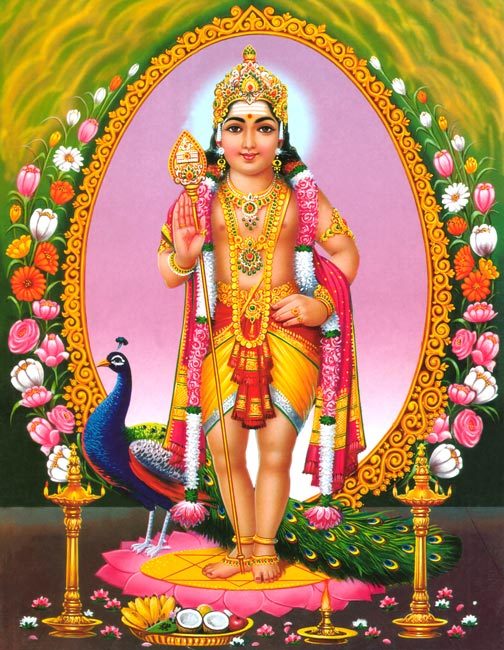
Murugan é conhecido por vários nomes em textos antigos e medievais da cultura indiana. Os mais comuns entre eles são Mahasena, Kartikeya, Kumara, Shanmukha, Skanda e Subrahmanya. Ele é o deus Hindu da guerra. Ele é filho de Parvati e Shiva, irmão de Ganesha e um deus cuja história de vida tem muitas versões no Hinduísmo.
✨
Murugan – o Deus Hindu dos Tâmiles
Murugan é aclamado como ‘Thamizh kadavul’ - o Senhor dos Tâmiles por poetas e expoentes culturais Tâmiles que se orgulham da singularidade da cultura Tâmil. Murugan é uma divindade popular amplamente adorada em Tamil Nadu e também em Kerala, Karnataka e Srilanka. A veneração de Karthigeya ou Subramanya (outros nomes de Muruga) é muito esporádica em outras partes e segmentos linguísticos da Índia.
A miríade de nomes Tâmiles de Murugan
A palavra Murugan significa aquele que é formoso. Na Índia, é muito usual dar às crianças nomes populares de Deus. O nome Murugan e seus vários outros nomes, como Murugaiyan, Sivamurugan, Velmurugan, Saravanan, Karthigeyan, Senthil, Arumugam, Subramaniyan, Subbaiah, Subbarayan, Swaminathan, Velan, Kadirvel, Shaktivel, Kandyan (Skandaniyan), Kandaswamwam, Kandaswam Shivakumar, Shanmukham, Palani (na verdade é o nome de uma de suas moradas), Palaniswamy, Muthu Kumaran, Sakthi Kumar, Muthukumaraswamy, Dandapani, Dandayutapani etc., são amplamente usados para nomear crianças; na sua grande maioria, os nomes acima são muito típicos dos Tâmiles.
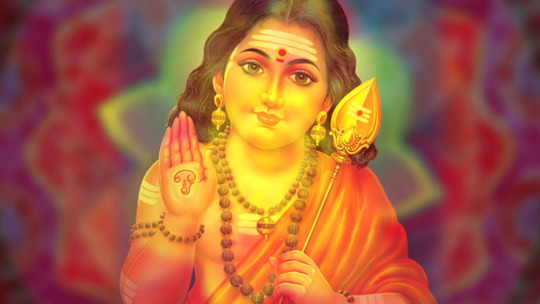
O nascimento de Murugan
Murugan é na verdade Subramanya, o filho do senhor Shiva. Segundo a mitologia, Murugan nasceu do fogo que emanava do terceiro olho do Senhor Shiva — o seu olho no meio da testa, quando ele o abriu para queimar Manmatha (ou Kamadeva, Senhor do amor e romance) que tentou perturbar a meditação de Shiva e assim voltar a sua mente para o romance. O verdadeiro propósito do nascimento de Muruga era aniquilar os dois demónios Tarakasura e Surapadma. Detalhes elaborados desta mitologia podem ser obtidos em “Skanda Puranam”. Também está disponível a versão poética Tâmil dessa mitologia, conhecida como “Kanda Puranam”, escrita pelo poeta Kacchiappa Sivachariyar (1350-1420).
Puranas
O Skanda Purana narra que Shiva se casou pela primeira vez com Dakshayani (também chamada de Sati), neta de Brahma e filha de Daksha. Daksha nunca gostou de Shiva, que, simbolizando destruição e desapego, mendiga por comida, dança num cemitério, manchado de cinzas, e não tem posses, nem mesmo boas roupas para se cobrir. Daksha insultou publicamente Shiva numa cerimónia de Yagna, e Sati se imolou pela exasperação causada pelo tratamento dado a Seu marido. O Yagna foi destruído pelos ganas de Shiva liderados por Virabhadra. Shiva retirou-se do universo e dedicou-se à meditação iogue nos Himalaias.
Nesse ínterim, Surapadman (um asura) devastou a terra e atormentou os seus seres. Tarakasuran acreditava que, pelo facto de Shiva ser um asceta e o seu casamento anterior ter sido conduzido com grande dificuldade, o seu novo casamento estava fora de questão, portanto, a bênção que tinha recebido de ser morto apenas pelo filho de Shiva dar-lhe-ia invencibilidade.
Os deuses perceberam que apenas o filho nascido de Shiva poderia levar os deuses à vitória sobre Tarakasuran, Surapadman e seus companheiros. Conspiraram com Manmatha, também conhecido como Kamadeva, o Deus do amor, para disparar do seu arco uma flecha de flores sobre Shiva, enquanto ele estava sentado em meditação, para o fazer apaixonar-se por Parvati (que era Dakshayani, renascida). Quando Kamadeva apontou a sua flecha, Shiva abriu o seu terceiro olho e incinerou-o reduzindo-o a cinzas instantaneamente.
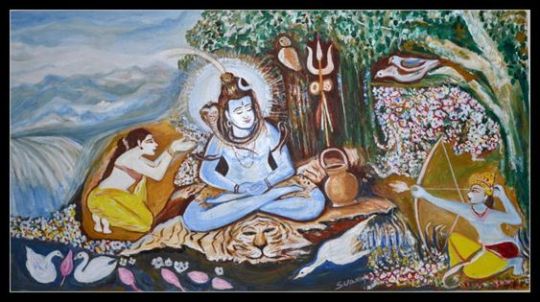
Shiva entregou o seu esplendor do terceiro olho, usado para destruir Manmatha, a Agni, pois só este era capaz de lidar com ele até que se tornasse o filho desejado. Até mesmo Agni, torturado pelo seu calor, o entregou a Ganga, que por sua vez o transportou para a Floresta Saravana e o depositou num lago de juncos chamado Saravana Poigai (localizado na foz do rio Ganges), onde as centelhas se tornaram em seis meninos. Eles foram criados pelas seis Krittika ou Kartika - as estrelas que compõem as Plêiades, adquirindo o nome de Karthikeya. Parvati combinou estes seis bebés num só com seis faces, ou seja, Shanmukha ou Arumugan. Como ele nasceu em Saravana, também foi chamado de 'Saravanabhava'.
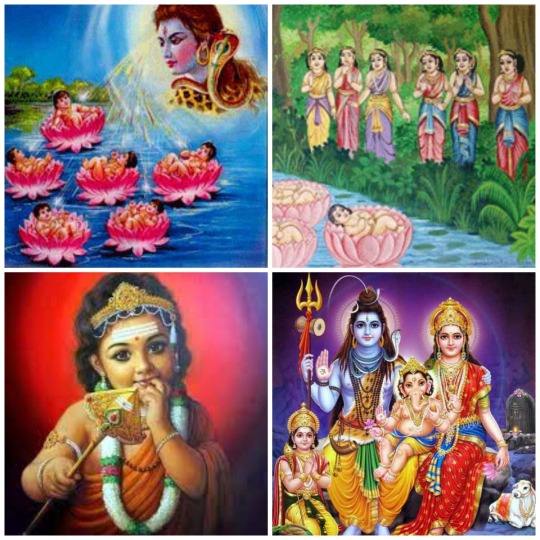
Murugan tornou-se o general supremo dos semi-deuses, então escoltou os devas e liderou o exército dos devas à vitória contra os asuras.
O veículo de Murugan é o pavão e a sua principal arma para destruir os seus inimigos é "Vel" (a lança). A sua bandeira do exército (“kodi“) tem o símbolo do galo (“seval“) e por isso é também conhecida como “Seval Kodiyon“.
Segundo a mitologia, Lord Murugan é casado com duas esposas, Devayani (filha de Indra, o rei dos Devas) e Valli. Valli pertence a uma comunidade tribal Tamil.
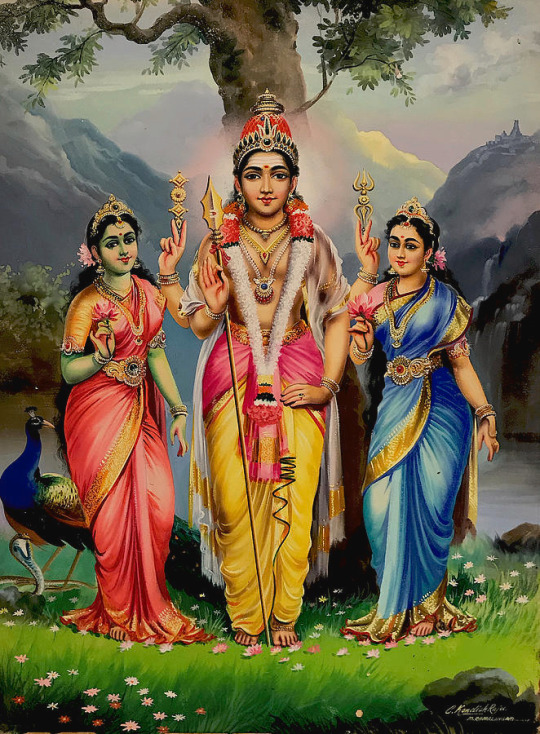
Murugan e Gyana (Conhecimento Supremo)
Mahavakyas - "As grandes declarações" das Upanishads:
प्रज्ञानम् ब्रह्म, Prajñānam Brahm, Consciência é Deus. ~ Aitareya Upanishad (Capítulor 3, versículo 3)
अहं ब्रह्मास्मि, Ahaṁ Brahmāsmi ~ Brihadaranyaka Upanishad 1.4.10 do Shukla Yajur Veda
Aham (अहं) significa ���Eu”, Brahm (ब्रह्म) significa todas as possibilidades e Asmi (अस्मि) significa “sou”.
तत्त्वमसि, Tát Túvam Asi ~ Chandogya Upanishad 6.8.7 do Sama Veda
tát (तत्) significa “Aquilo”, túvam significa “Tu”, Asi “és”. Simplificando, Tu és aquilo.
🌺 ॐ 🌺
Perceber a verdade mais elevada do Atman, e a sua unidade com o Brahman, chama-se de gyana (conhecimento verdadeiro) no Hinduísmo. Alcançar esse conhecimento também é conhecido como a abertura do “terceiro olho” numa pessoa. O Senhor Murugan, que nasceu devido à abertura do terceiro olho do Senhor Shiva, é um conhecedor da verdade suprema e é, portanto, referido como “Gyana Panditan” (um expoente do Conhecimento Supremo).
Diz-se que a sagrada sílaba Hindu “Om” encapsula o Conhecimento Supremo; aquele que conhece o significado mais profundo do Om é de facto um Gyani que conhece a Verdade Suprema. De acordo com a mitologia, Murugan, mesmo quando menino, estava ciente do significado do Om.
Numa ocasião, Murugan transmitiu uma upadesa secreta sobre o pranava, o som do Om, a Shiva e, assim, ganhou o título de "Guru de Shiva".
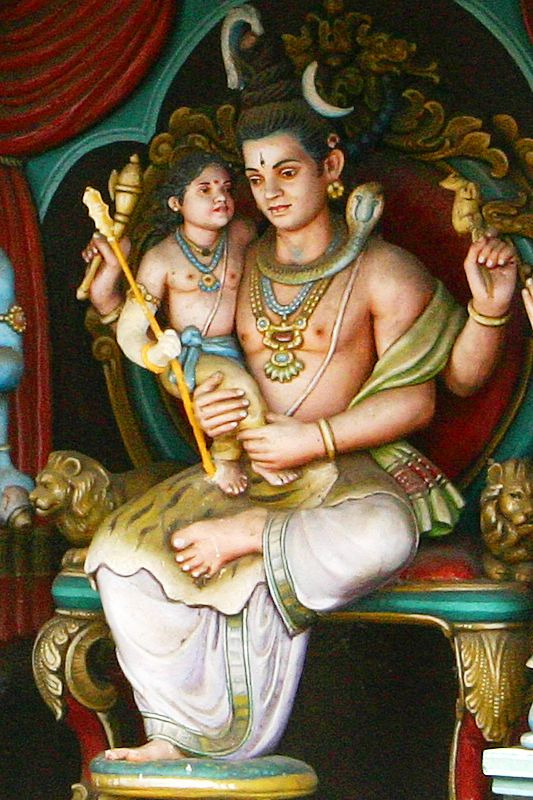
Visto que Murugan se tornou um Guru (Swami) que ensinou ao próprio Senhor (Natha) do universo, ele foi chamado de Swaminathan. Em Tamil, ele é saudado como “Thagappan Sami” - aquele que se tornou um Guru de seu próprio pai.
✨
Ramana Maharshi como Skanda filho de Shiva
Bhagavan Sri Ramana Maharshi, a própria personificação do Brahman supremo infinito sem começo, o Satchitananda (existência, consciência, bem-aventurança), é considerado por seus devotos ardentes como uma encarnação do Senhor Muruga. Embora não tenha escrito nenhum hino sobre Muruga, os seus poemas de significado profundo são uma fonte de tesouro que contém a essência dos seus ensinamentos filosóficos.
Maharshi Ramana ensinou dois caminhos como principais práticas espirituais (sadhanas) para a obtenção do Auto-Conhecimento, que é o estado de felicidade eterna, perfeita e pura. O primeiro caminho que ele ensinou é o caminho da Auto-inquirição, isto é, conhecer a si mesmo (a nossa própria natureza real) investigando “Quem sou eu?”, e o segundo caminho é o caminho da auto-entrega, ou seja, render-se (o ego) completamente a Deus. O primeiro é o caminho do conhecimento ou gyana (jnana marga), e o último é o caminho da devoção (bhakti marga).
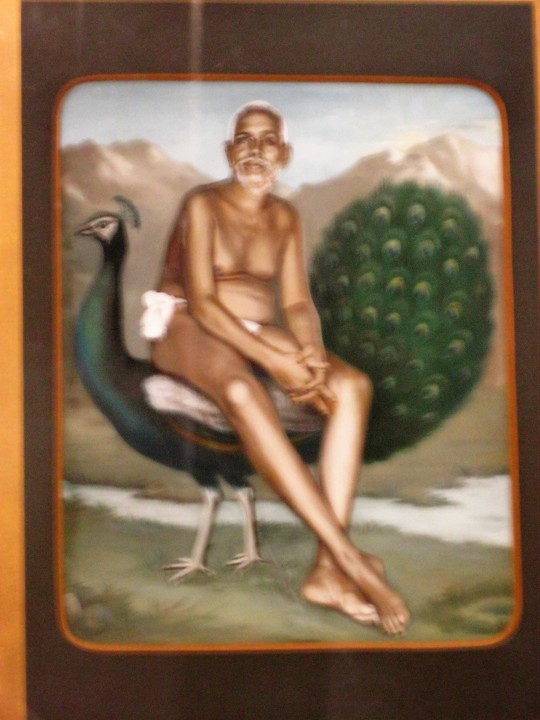
✨
As 6 grandes moradas de Murugan em Tamil Nadu
Os seis locais em que Karthikeya permaneceu enquanto liderava os seus exércitos contra Surapadman:
Swamimalai - Arulmigu Swaminatha Swamy Temple - Um templo muito famoso de Swaminathan (ou seja, Murugan), situado em Swamimalai (perto de Kumbakonam em Tamil Nadu, Índia), é tratado como o lugar mais sagrado onde Lord Murugan pregou o Pranav Mantra "OM" para o Seu pai Lord Shiva quando era uma criança.
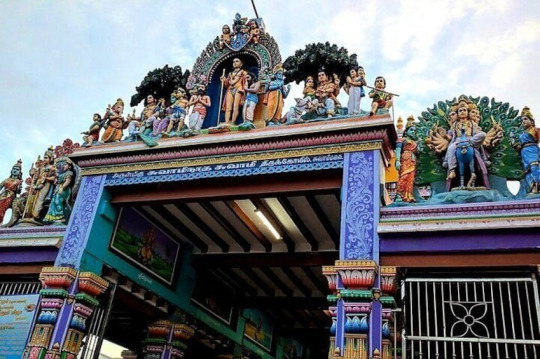
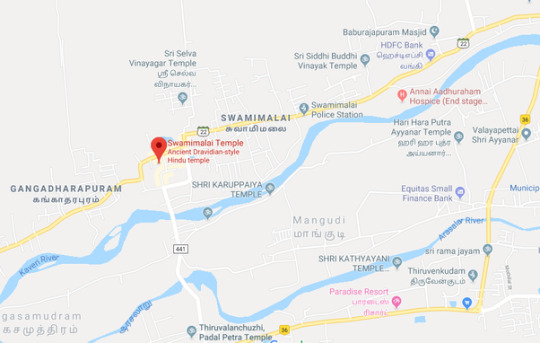
As outras 5 moradas são : Tiruttanikai, Tiruvavinankudi (Palani), PazhamudirSolai, Tirupparamkunram and Tiruchendur.
“Thirumurugatruppadai” é uma literatura Tâmil famosa e antiga escrita pelo poeta Nakkirar do período Sangam (por volta do século III AD), que contém as histórias da maravilhosa peça divina do Senhor Murugan em todas estas 6 moradas principais.
Estes seis locais, em conjunto, passaram a ser conhecidos como "Arupadai Veedu" (Língua Tâmil), significa os seis campos de batalha do Senhor.
Adoração em Tamil Nadu
Thai Poosam durante Janeiro-Fevereiro é um festival celebrado durante 6 dias. No dia de Thai Poosam, Kavadis e Palkudams são levados pelos devotos em procissão à volta de Chhedanagar. Abhishekams especiais são realizados to the Moolavar and Utsavar (moorthi da divindade geralmente levada durante as procissões do festival do templo; utsavar moorthi geralmente é feito de metal, e Moolavar murthi geralmente é feito de pedra). Annadhanam (A Oferta Sagrada de Alimento) é fornecida a todos os devotos que participam das funções. À noite, o Senhor Muruga é levado em procissão acompanhado por Nadaswaram (instrumento musical), Veda Parayanam, à volta de Chhedanagar.
Dia de Vaikasi Visakam, durante Maio-Junho, Kavadis (Kavadi é uma 'carga física' feita de uma estrutura elaborada e decorada, colocada nos ombros de uma pessoae) e Palkudams (jarros de leite) são levados pelos devotos em procissão à volta de Chhedanagar.
Skanda Sashti durante Outubro-Novembro é um festival celebrado durante 6 dias. São organizados discursos espirituais por eruditos e/ou concertos musicais de artistas populares do Sul ou de Mumbai.
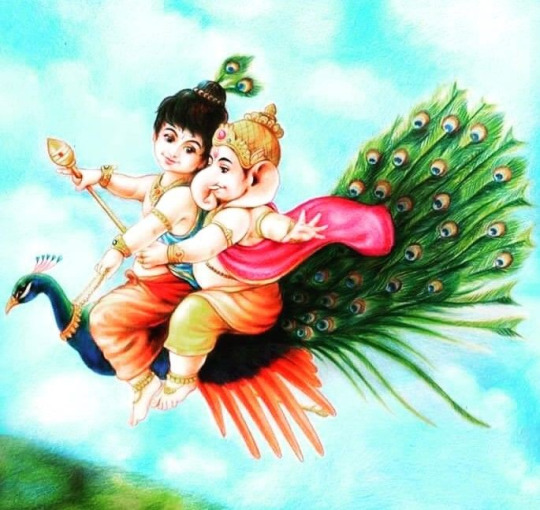
#Bhagavan Sri Ramana Maharshi#Kartikeya Karttikeya Skanda Kumara Murugan Mahasena Shanmukha Subrahmanya#Pranava OM#Arupadai Veedu#mahavakya#Tu És Aquilo
8 notes
·
View notes
Text
Skanda Tamil Reference 20,000 years ago
There was a comment to my article on Siva Worship in Tamil asking me to write an article on the worship of Skanda in Vedic literature and in Tamil.
This seems to be a reaction to Self styled Rationalists/Tamil scholars, who has taken a vow to denigrate Hinduism/ Sanatana Dharm , divide India as North and South and insult Hindu Godd in filthy language. It is worth noting that these persons are…
View On WordPress
#Arupadai Veedu#கந்தன்#தமிழ் இலக்கியத்தில் கந்தன்#திருமுருகாற்றுப்படை#ஸ்கந்தன்#Murugan#Skanda#Skanda worship Tamil#Subramanya
0 notes